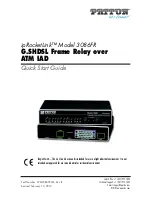
33
33
System Noise Figure and C/N0
33
Appendix B
System Noise Figure and C/N0
The system noise figure, in dB, can be calculated as:
NFsys = 10*log
10
(10
NFant/10
+ (10
NFrx/10
-1)/10
Gpreamp/10
)
where
•
NFant is the antenna LNA noise figure, in dB;
•
NFrx is the module noise figure, in dB. NFrx depends on the net gain, but a good
approximation (<0.5dB) of NFsys can be obtained by setting NFrx = 10dB. Seel also
section 2.4;
•
Gpreamp is the net pre-amplification in front of the module, in dB.
For example, with a 2.5-dB antenna LNA noise figure, 30-dB antenna LNA gain and 15-dB
cable loss, Gpreamp = 30dB-15dB = 15dB. In this case, the system noise figure is:
NFsys = 10.log
10
(10
2.5/10
+ (10
10/10
-1)/10
15/10
) = 3.14 dB.
The C/N0, in dB-Hz, of a GNSS signal received at a power P can be computed by:
C/N0 = P - 10.log
10
(Tant + 290*(10
NFsys/10
-1)) + 228.6 dB
where
•
P is the received GNSS signal power including the gain of the antenna passive
radiating element, in dBW (e.g. -155dBW)
•
Tant is the antenna noise temperature, in Kelvin. Typically Tant = 130K for an open-
sky antenna.
•
228.6 is -10*log10(k
B
) with k
B
=1.38e-23 J/K the Boltzmann constant.
Note that, when connecting the module directly to a GNSS simulator, the applicable value
for NFsys is equal to NFrx and Tant=290K.




































